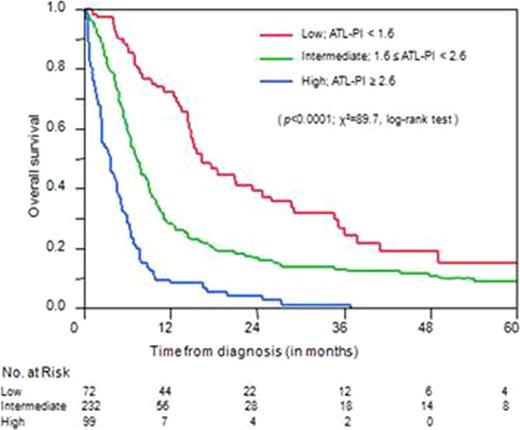Abstract
Adult T-cell leukemia/lymphoma (ATL) is a peripheral T-cell malignancy caused by human T-lymphotropic virus type I (HTLV-1). HTLV-1 is endemic to the southwestern region of Japan, Caribbean basin, Central and South America, and western Africa. A previous report by the Japan Clinical Oncology Group-Lymphoma Study Group (JCOG-LSG) identified five prognostic factors: advanced performance status (PS), high lactic dehydrogenase (LDH), age of 40 years or older, total involved lesions, and hypercalcemia, based on an analysis of 854 patients with newly diagnosed ATL registered between 1983 and 1987. The JCOG-LSG then proposed 4 clinical subtypes: acute, lymphoma, chronic, and smoldering types. In general, the prognosis of acute and lymphoma type ATL is similarly very poor, whereas that of the chronic and smouldering types is better. It has come to the attention of clinicians that there are diverse clinical courses and treatment outcomes among patients with acute and lymphoma type ATL. Therefore, it is necessary to establish a prognostic index (PI) for a risk-adapted approach and improving the quality of clinical trials. The aim of this study was to develop the first PI for acute and lymphoma type ATL (ATL-PI).
We conducted a nationwide retrospective survey of ATL patients who were newly diagnosed between January 2000 and December 2009, and 1,270 patients with acute and lymphoma type were registered. Fully eligible 807 individuals excluding patients who have received allogeneic hematopoietic stem cell transplantation were used for this analysis, and randomly split the dataset into training (n=404) and validation (n=403) samples. We applied a multivariable fractional polynomial model using continuous variables, and then developed the simplified one using dichotomizing variables.
The overall median survival time (MST) for 807 patients was 7.7 months. The Ann Arbor stage (I - II vs. III - IV), performance status (0–1 vs. 2–4), and the three continuous variables of age, serum albumin, and soluble interleukin-2 receptor (sIL-2R) were identified as independent prognostic factors in the training sample. Using these variables, a prognostic model was devised to identify three groups at different levels of risk. In the validation sample, MSTs were 3.6, 7.3, and 16.2 months for patients at high, intermediate, and low risk, respectively (p<0.0001).
ATL-PI = 0.65 (if Stage = III or IV) + 0.35 (if PS > 1) + 0.016 × Age (years) − 0.36 × Albumin (g/dL) + 0.37 × log10 (sIL2R (U/mL))
To make the scoring system simpler and clinically practicable, we also simplified the original ATL-PI by dichotomizing age at 70 years, serum albumin at 3.5 g/dL, and sIL-2R at 20,000 U/mL and subsequently fitted a multivariate Cox model based on these dichotomizations in the training sample. Then, we derived a simplified ATL-PI as follows:
Simplified ATL-PI = 2 (if Stage = III or IV) + 1 (if PS > 1) + 1 (if Age > 70) + 1 (if Albmin < 3.5) + 1 (if sIL2R > 20,000)
The scores from 0 to 2 were categorized into low risk group, 3 and 4 into intermediate risk, and from 5 to 6 into high risk group. This classification yielded a good separation of OS curves (p<0.0001), and high concordance to the original ATL-PI in the validation sample.
We identified 5 prognostic factors in acute and lymphoma type ATL using a multivariable fractional polynomial model, and further simplified it with minimal loss of the original index. The ATL-PI enables us to distinguish 3 different groups by predicting OS at the time of diagnosis. The ATL-PI, the first PI for acute and lymphoma type ATL, may be a promising platform in consideration of the choice of optimal treatment by risk-stratification and for well-controlled clinical trials.
No relevant conflicts of interest to declare.

This icon denotes a clinically relevant abstract
Author notes
Asterisk with author names denotes non-ASH members.


This feature is available to Subscribers Only
Sign In or Create an Account Close Modal